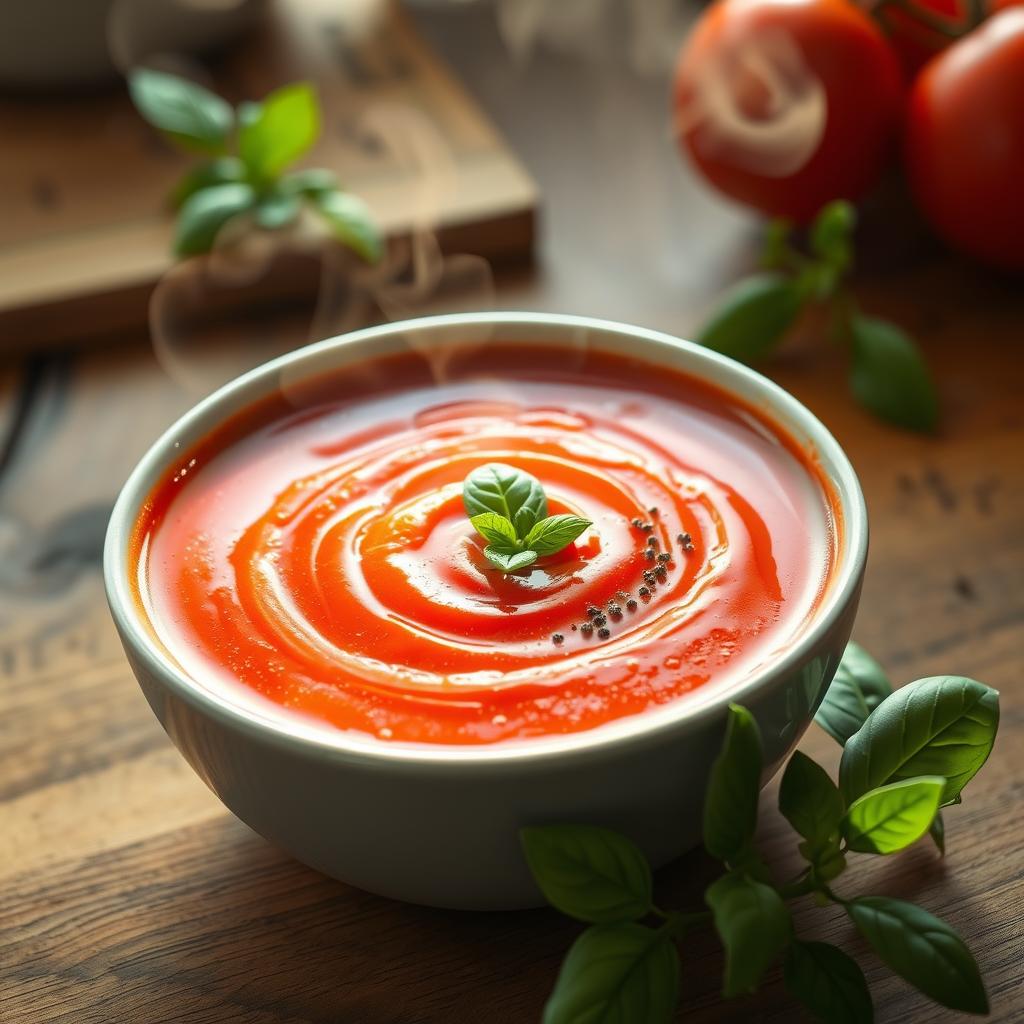Are you craving a comforting bowl of tomato soup that pairs perfectly with grilled cheese sandwiches? Look no further! Making a delicious homemade tomato soup is easier than you think.
You can create a creamy or chunky soup according to your preference, and the best part is that it can be prepared in about 30 minutes. This easy-to-make dish is perfect for a quick weeknight dinner or a cozy weekend lunch.
With this simple recipe, you’ll learn how to achieve the perfect balance of flavors in your tomato soup. We’ll guide you through selecting the best ingredients and provide serving suggestions to complement your meal.
Key Takeaways
- Learn how to make a delicious homemade tomato soup in 30 minutes.
- Discover the secret to achieving the perfect balance of flavors.
- Get tips on selecting the best ingredients for your soup.
- Find serving suggestions to complement your tomato soup.
- Customize your soup to your taste preferences.
The Perfect Comfort Food: Homemade Tomato Soup
Tomato soup, made from scratch, is a simple yet satisfying meal that’s perfect for any time of the year. By choosing to make your tomato soup from scratch, you’re not only ensuring a delicious meal but also reaping numerous health benefits.
Why Make Tomato Soup From Scratch
Making tomato soup from scratch allows you to control the ingredients, ensuring that your soup is free from unwanted preservatives and excess salt. This approach also enables you to customize the flavor to your liking, making it a truly personal and satisfying experience. Moreover, the process of cooking from scratch can be therapeutic, allowing you to unwind and enjoy the fruits of your labor.
Health Benefits of Tomato Soup
Tomatoes are rich in lycopene, a powerful antioxidant that may help reduce the risk of heart disease and certain cancers. A serving of tomato soup contributes to your daily vegetable intake while providing essential vitamins and minerals. The cooking process increases the bioavailability of certain nutrients in tomatoes, making soup an excellent way to enjoy their benefits. Here are some key health benefits:
- A serving of soup provides fiber and a range of nutrients that support overall health.
- Tomato soup is relatively low in calories, with creamy versions ranging around 220-240 calories per serving.
- The combination of vegetables in most tomato soup recipes provides a boost to your daily nutrient intake.

Essential Ingredients for Classic Tomato Soup
Creating a classic tomato soup requires a thoughtful selection of ingredients to achieve the perfect balance of flavors. The quality of your ingredients directly impacts the final taste and texture of your soup. Let’s break down the essential components that make up this comforting dish.
Tomato Options: Fresh vs. Canned
The star of the show is, of course, the tomatoes. You can use either fresh or canned tomatoes, depending on the season and your personal preference. Fresh tomatoes offer a brighter, more vibrant flavor, while canned tomatoes provide a consistent taste and texture year-round. When using fresh tomatoes, be sure to choose ripe ones for the best flavor. Canned tomatoes, particularly San Marzano, are known for their sweeter and less acidic taste.

Aromatics and Seasonings
Aromatics like onions, garlic, and celery form the flavor base of your soup. Sauteing these ingredients before adding the tomatoes enhances their natural sweetness and depth. Seasonings such as salt, pepper, and herbs like basil or oregano add complexity to the flavor profile. Don’t forget to adjust your seasonings as you go to ensure a well-balanced taste.
Liquid Base Options
The liquid base of your soup can be either chicken or vegetable broth, with the latter being a great option for vegetarians. Some recipes use water, but broth adds richness and depth. For a creamier soup, you can incorporate cream or heavy cream towards the end of cooking. This not only enhances the texture but also helps balance the acidity of the tomatoes.
| Liquid Base | Flavor Profile | Texture |
|---|---|---|
| Chicken Broth | Rich, savory | Thick, comforting |
| Vegetable Broth | Milder, vegetarian-friendly | Similar to chicken broth |
| Water | Light, tomato-forward | Variable, depending on tomato quantity |
| Cream or Heavy Cream | Rich, creamy | Luxuriously smooth |
Equipment You’ll Need
The right equipment can make all the difference in preparing a tasty tomato soup. When it comes to making soup, having the appropriate tools can simplify the process and improve the final result.
Blending Tools for Smooth Soup
For a smooth tomato soup, you’ll need a reliable blending tool. An immersion blender is ideal for blending the soup directly in the pot, reducing cleanup and minimizing the risk of splashing hot soup. Alternatively, you can use a regular blender, but be sure to blend in batches and vent the lid to avoid pressure buildup.

Cooking Vessels: Choosing the Right Pot
Choosing the right pot is crucial when making tomato soup. A non-reactive pot is essential to prevent acidic tomatoes from reacting with the metal. Stainless steel, enamel-coated cast iron (Dutch oven), ceramic, or glass pots are excellent choices. A heavy-bottomed pot or Dutch oven distributes heat evenly, preventing scorching. Avoid using aluminum, uncoated cast iron, or copper pots, as they can react with tomatoes and create off-flavors. Opt for a pot with a capacity of at least 4-5 quarts to provide enough space for the soup to simmer without overflowing.
Preparing Your Tomato Soup Recipe
The preparation process is crucial in bringing out the best flavors in your tomato soup recipe. To start, you’ll need to prep your vegetables and build a flavorful base.
Prepping the Vegetables
Prepping the vegetables is a straightforward process that involves chopping and preparing the ingredients for sautéing. You’ll need to chop your onions and mince your garlic. The size of your chop can affect the texture and distribution of flavor in your soup.

For a smooth soup, you may want to chop your vegetables finely. However, if you prefer a chunkier texture, you can leave them a bit larger. Regardless, the key is to ensure they’re ready for the pot.
Building the Flavor Base
Building the flavor base involves sautéing your chopped onions in butter or olive oil over medium heat. This step is crucial as it develops the sweetness in the onions, which balances the acidity of the tomatoes.
- Begin by heating butter or olive oil in your pot over medium heat to create the foundation of flavor.
- Sauté onions until they become translucent and slightly golden.
- Add garlic after the onions have softened to prevent burning.
For added depth, some recipes suggest browning tomato paste before adding the main tomatoes. This step enhances the overall flavor profile of your soup recipe.
| Ingredient | Purpose | Preparation Tip |
|---|---|---|
| Onions | Adds sweetness | Chop finely for smooth soup |
| Garlic | Enhances flavor | Mince to prevent burning |
| Butter/Olive Oil | Creates flavor base | Use over medium heat |
Step-by-Step Cooking Instructions
To make a delicious homemade tomato soup, follow these easy-to-follow cooking instructions. The process involves several key steps that will help you achieve a flavorful and comforting soup.
Sautéing the Aromatics
Begin by heating a couple of tablespoons of olive oil in a large pot over medium heat. Add finely chopped onions and cook until they’re translucent, which should take about 5 minutes. Then, add minced garlic and cook for another minute, stirring constantly to prevent burning. This step is crucial as it lays the foundation for the overall flavor of your tomato soup.
Adding Tomatoes and Broth
Next, add your tomatoes along with some broth to the pot. You can use either fresh or canned tomatoes, depending on your preference and what’s available. If using canned, look for ones that are low in sodium. Pour in enough broth to cover the tomatoes and bring the mixture to a boil. Then, reduce the heat to low and let it simmer.

Simmering to Perfection
Allow the soup to simmer for about 20 minutes, or until the flavors have melded together and the tomatoes are tender. This slow cooking process helps to develop a rich and deep flavor profile in your soup.
Blending for Desired Consistency
Once your soup has simmered, it’s time to blend it to your desired consistency. For a smooth soup, you can use an immersion blender directly in the pot, or carefully transfer the soup to a standard blender in batches. If you prefer a chunkier soup, you can blend it partially or use a potato masher. Here are some tips for blending:
- For the smoothest results, use an immersion blender gently in the pot.
- If using a standard blender, work in small batches and be cautious with hot liquids.
- Blend until you reach your desired consistency, whether that’s silky smooth or slightly chunky.
| Blending Method | Consistency | Tips |
|---|---|---|
| Immersion Blender | Smooth | Use directly in the pot for ease. |
| Standard Blender | Smooth to Chunky | Blend in batches, be cautious with hot soup. |
| Potato Masher | Chunky | Ideal for those who prefer a more rustic texture. |
By following these steps, you’ll be able to create a delicious and comforting tomato soup that’s perfect for any occasion.
Creamy Tomato Soup Variations
Discover how to make your tomato soup creamy and delicious with a few simple adjustments. You can enhance the flavor and texture of your soup by incorporating various creamy elements.
Adding Cream or Milk
Adding cream or milk is a straightforward way to enrich your soup. You can stir in heavy cream, half-and-half, or whole milk towards the end of cooking to prevent curdling. This addition not only enhances the texture but also helps balance the acidity in your tomato soup.
Dairy-Free Creamy Options
If you’re looking for dairy-free alternatives, consider using coconut cream or cashew cream. Coconut cream adds a rich, creamy texture, while cashew cream provides a subtle nutty flavor. Simply blend cooked cashews with water to create a creamy consistency.
Balancing Acidity in Tomato Soup
Tomato soup can sometimes be too acidic. To balance this, you can add a pinch of sugar to counteract the acidity. Alternatively, a small amount of baking soda can also help neutralize the acidity. Adding a grated carrot during cooking can add natural sweetness, thereby balancing the flavor.
| Method | Effect |
|---|---|
| Adding 1-2 teaspoons of sugar | Balances acidity without making the soup sweet |
| Using cream or butter | Enhances texture and mellow acidity |
| Adding a pinch of baking soda | Neutralizes acidity |
| Roasting tomatoes before making soup | Reduces acidity naturally and concentrates sweetness |
Flavor Enhancers and Add-ins
To take your tomato soup to the next level, consider adding some flavor enhancers and ingredients that complement its rich taste. Enhancing your tomato soup can be as simple as adding a sprinkle of herbs or as involved as mixing in additional ingredients for texture and flavor.
Herbs and Spices That Complement Tomatoes
Certain herbs and spices can significantly enhance the flavor of your tomato soup. Basil, oregano, and thyme are popular choices that complement the tomato flavor. You can add these herbs fresh or dried, depending on your preference and what’s available.
Secret Ingredients for Depth of Flavor
Adding a splash of acidity, such as a squeeze of fresh lemon juice, can brighten the flavors in your soup. Another secret ingredient is a pinch of sugar, which can balance out the acidity of the tomato. These simple additions can add depth to your soup.
Adding Protein to Your Soup
You can make your soup more substantial by adding protein-rich ingredients. White beans or chickpeas are excellent options as they blend into the soup, adding protein and fiber without changing the flavor profile. Alternatively, you can add cooked chicken, shrimp, or even a sprinkle of grated cheese on top to enhance the protein content and flavor of your tomato soup recipes.
Serving Suggestions and Pairings
The perfect pairing can turn a simple bowl of tomato soup into a satisfying meal. You can elevate your dining experience with a few thoughtful accompaniments.
The Classic Grilled Cheese Companion
A grilled cheese sandwich is a timeless companion to tomato soup. You can make it even more special by using artisanal bread and a blend of cheese for a richer flavor. For a twist, consider adding some fresh basil leaves to your grilled cheese for an extra layer of taste.
Other Delicious Accompaniments
Besides the classic grilled cheese, there are many other ways to enjoy your tomato soup. Here are some ideas:
- Crusty artisan bread or homemade garlic bread makes an excellent accompaniment for dipping into tomato soup.
- Crunchy homemade croutons sprinkled on top add textural contrast to smooth soup.
- A simple green salad with a bright vinaigrette provides a fresh counterpoint to the rich, warm soup.
- For an elegant presentation, add a small dollop of pesto or a swirl of cream and a few fresh basil leaves on top.
| Accompaniment | Description |
|---|---|
| Crusty Bread | Perfect for dipping into your tomato soup |
| Croutons | Adds a crunchy texture to your soup |
| Green Salad | Provides a fresh contrast to the warm soup |
| Pesto or Cream | Adds an elegant touch with a dollop on top |
Storing and Reheating Your Tomato Soup
Proper storage and reheating are crucial to enjoying your homemade tomato soup at its best. After investing time in making a delicious batch, you want to ensure it remains fresh and tasty for as long as possible.
Refrigeration Tips
When storing your soup in the refrigerator, it’s essential to cool it down quickly to prevent bacterial growth. You can do this by transferring the soup to shallow containers and placing them in an ice bath. Once cooled, store the soup in airtight containers in the refrigerator.
Storage Time: Your tomato soup can be safely stored in the refrigerator for up to 3 to 4 days.
Freezing for Later Use
For longer storage, freezing is an excellent option. Freeze your tomato soup in airtight containers or heavy-duty freezer bags. It’s best to freeze the soup before adding any dairy products to prevent separation or texture changes. Leave about an inch of headspace in containers as the soup will expand when frozen.
| Storage Method | Storage Time | Tips |
|---|---|---|
| Refrigeration | 3-4 days | Cool soup quickly, store in airtight containers |
| Freezing | Up to 3 months | Leave headspace in containers, thaw overnight in refrigerator |
When you’re ready to enjoy your frozen tomato soup, thaw it overnight in the refrigerator and reheat it gently on the stovetop over medium-low heat, stirring occasionally. This process should take about 5-10 minutes.
Conclusion: Enjoying Your Homemade Tomato Soup
Once you’ve tasted the richness of your homemade tomato soup, you’ll wonder why you ever settled for store-bought versions. This versatile and satisfying soup can be customized to your taste preferences and dietary needs. You can double the recipe for larger batches or meal prep. Enjoy experimenting with different variations and add-ins to make this basic recipe your own. Your homemade tomato soup will become a staple, perfect for sharing with friends and family or savoring on your own.
FAQ
Can I use canned tomatoes instead of fresh ones for my tomato soup?
How do I achieve a creamy texture without using heavy cream?
What’s the best way to store leftover soup?
Can I make grilled cheese sandwiches in the oven instead of on the stovetop?
How can I enhance the flavor of my soup with garlic and basil?
What’s the best way to blend my soup for a smooth consistency?

Ingredients
- 1 tablespoon vegetable oil
- 1 cup chopped onion
- 2 cloves garlic, minced
- ½ cup chopped carrot
- ¼ cup chopped celery
- 2 (28-ounce) cans crushed tomatoes
- 3 ½ cups vegetable broth
- 1 tablespoon vegetarian Worcestershire sauce
- 1 teaspoon salt
- ½ teaspoon dried thyme
- ½ teaspoon ground black pepper
- 4 drops hot pepper sauce (optional)
Instructions
Heat oil in a large Dutch oven over medium-high heat.
Add onion and garlic; sauté until onion is tender.
Add carrot and celery; cook until tender, 7 to 9 minutes, stirring frequently.
Stir in tomatoes, vegetable broth, Worcestershire sauce, salt, thyme, black pepper, and hot sauce.
Reduce heat to low.
Cover Dutch oven; simmer 20 minutes, stirring frequently.
Nutrition Information (Per Serving)
Calories: 141 kcal
Fat: 3g
Carbohydrates: 27g
Protein: 5g
Quick Facts
Prep Time: 30 minutes
Cook Time: 30 minutes
Total Time: 1 hour
Servings: 6
Difficulty: ⭐⭐ (Easy)


